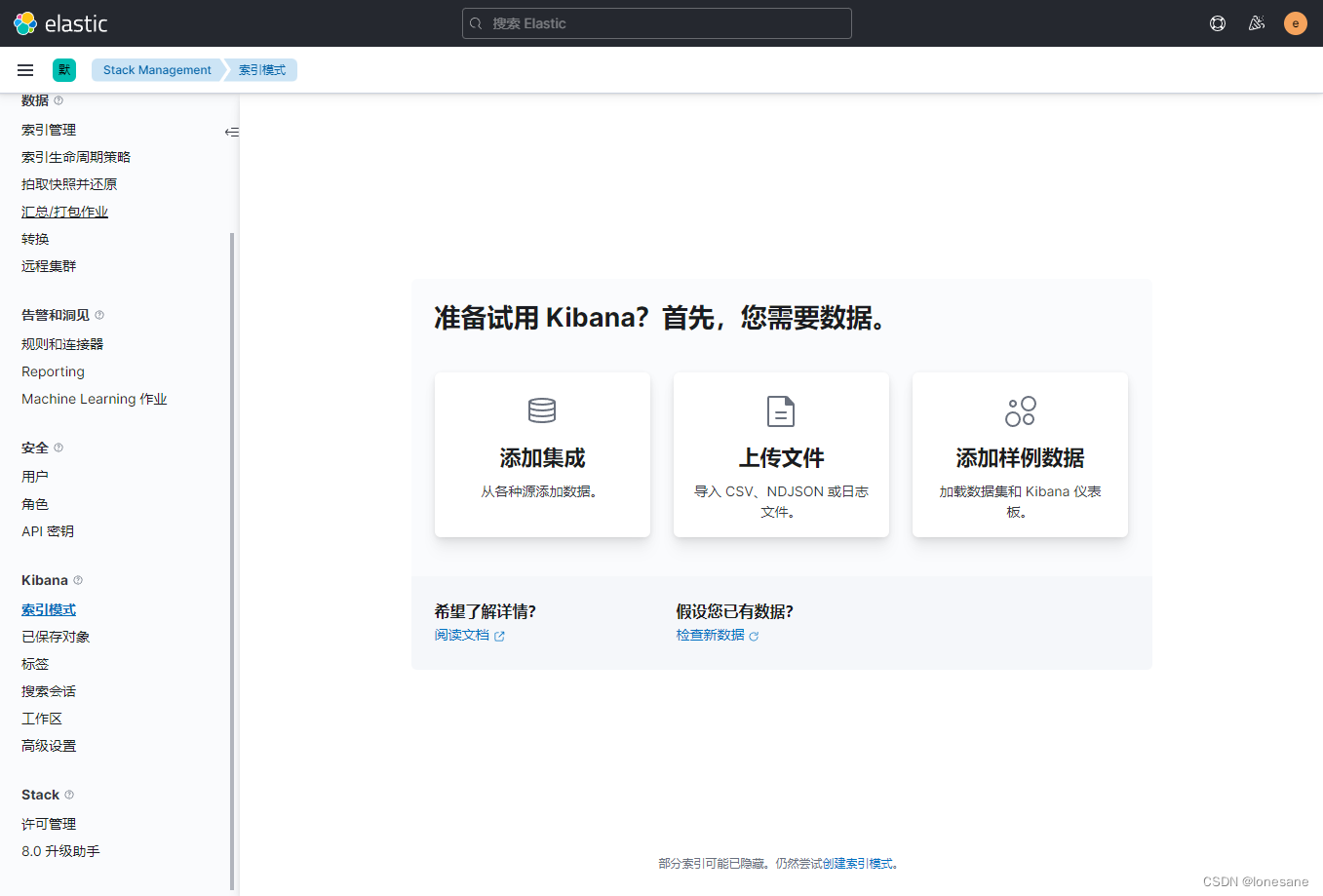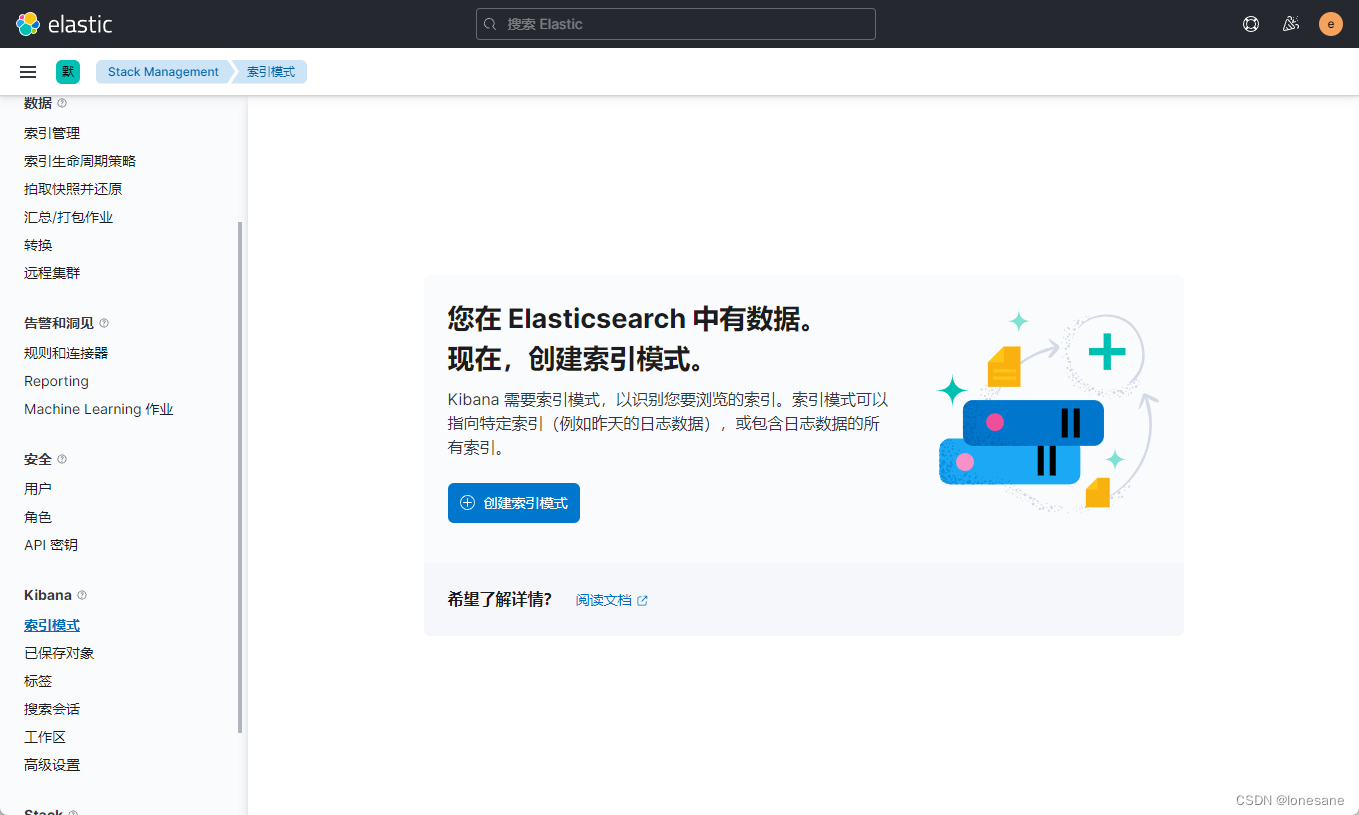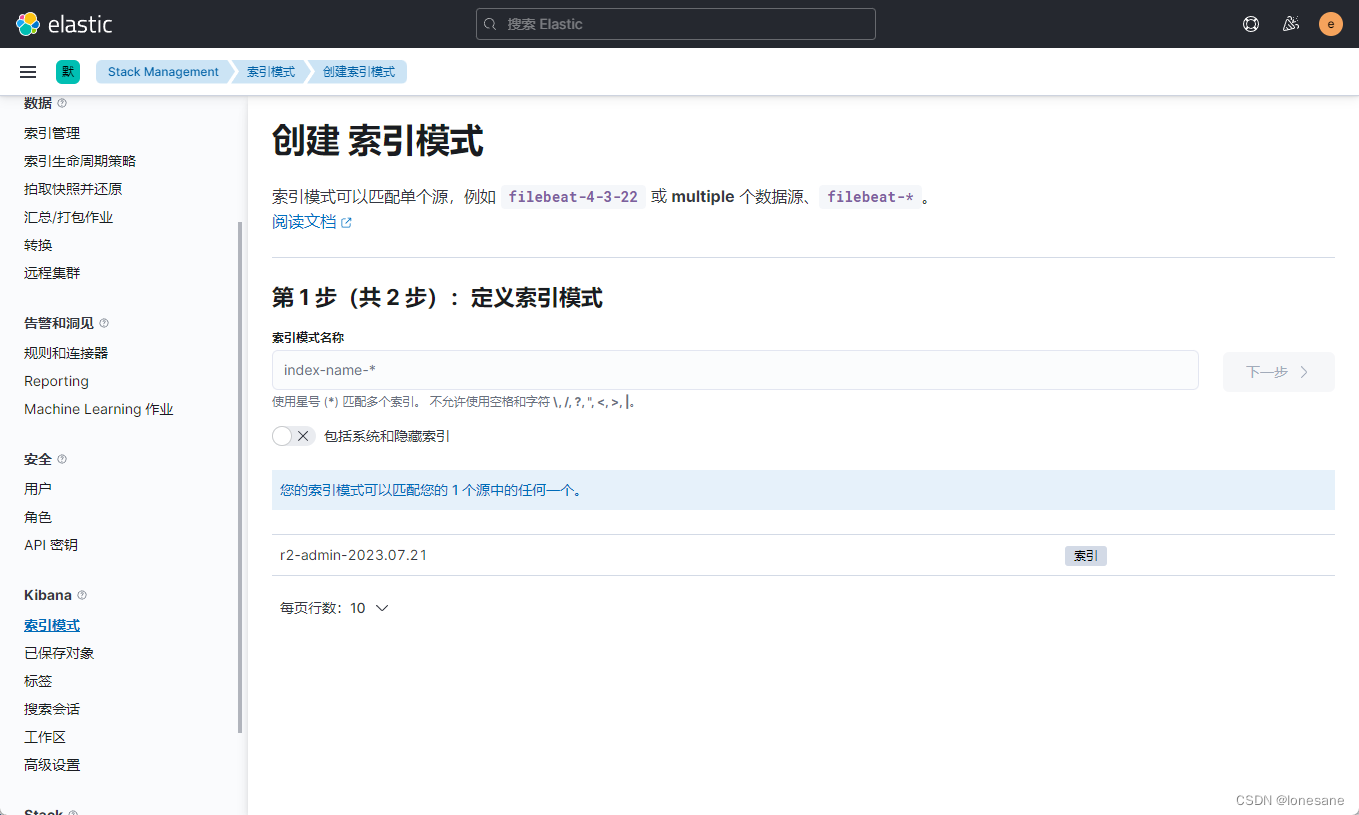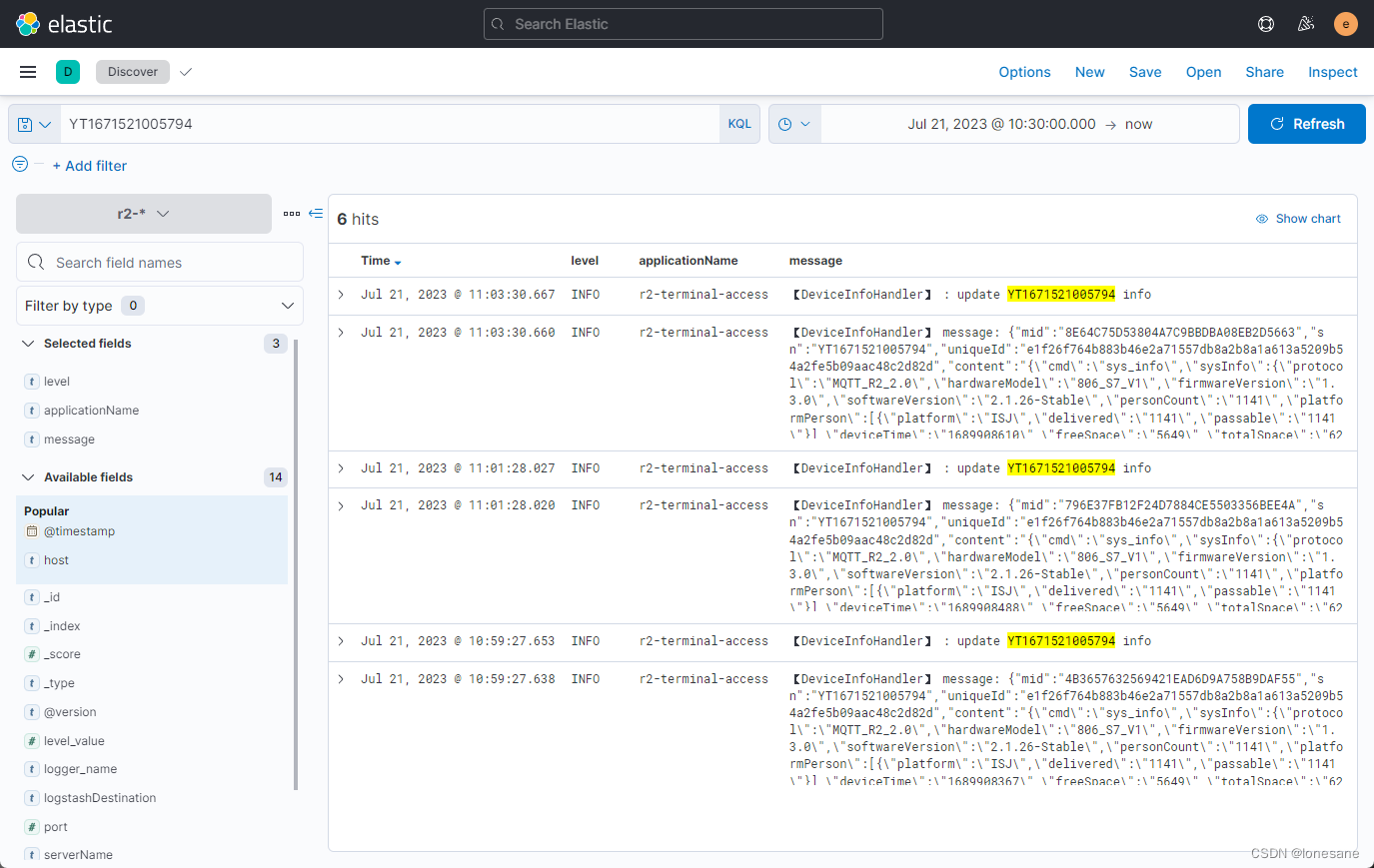K8S启用 nfs-client-provisioner
我们使用了nfs来进行数据存储,在elk配置中使用了nfs storageclass.所以先要启用nfs-client-provisioner
k8s部署ELK
1.创建单独的 namespace
# cat 00-ns.yaml
apiVersion: v1
kind: Namespace
metadata:
name: ns-elk
labels:
app: elasticsearch
2. 生成开启 x-pack 时的 ssl 证书
# docker run --name es-certutil -i -w /tmp docker.elastic.co/elasticsearch/elasticsearch:7.14.0 /bin/sh -c \
"elasticsearch-certutil ca --out /tmp/es-ca.p12 --pass '' && \
elasticsearch-certutil cert --name security-master --dns \
security-master --ca /tmp/es-ca.p12 --pass '' --ca-pass '' --out /tmp/elastic-certificates.p12"
# docker cp es-certutil:/tmp/elastic-certificates.p12 ./
// 生成 ssl 认证要使用的 secret elastic-certificates
kubectl -n ns-elk create secret generic elastic-certificates --from-file=./elastic-certificates.p12
3. 部署 elasticsearch master 节点
# cat 01-es-master.yaml
apiVersion: apps/v1
kind: StatefulSet
metadata:
namespace: ns-elk
name: elasticsearch-master
labels:
app: elasticsearch
role: master
spec:
serviceName: elasticsearch-master
replicas: 3
selector:
matchLabels:
app: elasticsearch
role: master
template:
metadata:
labels:
app: elasticsearch
role: master
spec:
containers:
- name: elasticsearch
image: docker.elastic.co/elasticsearch/elasticsearch:7.14.0
resources:
requests:
memory: 2Gi
cpu: 1.0
limits:
memory: 4Gi
cpu: 2.0
command: ["bash", "-c", "ulimit -l unlimited && sysctl -w vm.max_map_count=262144 && chown -R elasticsearch:elasticsearch /usr/share/elasticsearch/data && exec su elasticsearch docker-entrypoint.sh"]
ports:
- containerPort: 9200
name: http
- containerPort: 9300
name: transport
env:
# 使用修改环境变量的方式修改 elasticsearch 配置
- name: discovery.seed_hosts
value: "elasticsearch-master-0.elasticsearch-master.ns-elk.svc.cluster.local"
- name: cluster.initial_master_nodes
value: "elasticsearch-master-0,elasticsearch-master-1,elasticsearch-master-2"
- name: ES_JAVA_OPTS
value: -Xms2g -Xmx2g
- name: node.master
value: "true"
- name: node.ingest
value: "false"
- name: node.data
value: "false"
- name: cluster.name
value: "elasticsearch-cluster-v7"
- name: node.name
valueFrom:
fieldRef:
fieldPath: metadata.name
- name: xpack.security.enabled
value: "true"
- name: xpack.security.transport.ssl.enabled
value: "true"
- name: xpack.monitoring.collection.enabled
value: "true"
- name: xpack.security.transport.ssl.verification_mode
value: "certificate"
- name: xpack.security.transport.ssl.keystore.path
value: "/usr/share/elasticsearch/config/elastic-certificates.p12"
- name: xpack.security.transport.ssl.truststore.path
value: "/usr/share/elasticsearch/config/elastic-certificates.p12"
volumeMounts:
- mountPath: /usr/share/elasticsearch/data
name: pv-storage-elastic-master
- name: elastic-certificates
readOnly: true
mountPath: "/usr/share/elasticsearch/config/elastic-certificates.p12"
subPath: elastic-certificates.p12
- mountPath: /etc/localtime
name: localtime
# Gave permission to init container
securityContext:
privileged: true
volumes:
- name: elastic-certificates
secret:
secretName: elastic-certificates
- hostPath:
path: /etc/localtime
name: localtime
volumeClaimTemplates:
- metadata:
name: pv-storage-elastic-master
spec:
accessModes: [ "ReadWriteOnce" ]
storageClassName: "nfs-storage" #使用新建的sc
resources:
requests:
storage: 50Gi
部署后会报异常[“java.net.UnknownHostException: elasticsearch-master-0.elasticsearch-master.ns-elk.svc.cluster.local: Name or service not known”,这是因为服务没有暴露,节点名无法解析导致的,可以先行执行步骤6里的部分来解决。
4. 部署 elasticsearch data 节点
apiVersion: apps/v1
kind: StatefulSet
metadata:
namespace: ns-elk
name: elasticsearch-data
labels:
app: elasticsearch
role: data
spec:
serviceName: elasticsearch-data
replicas: 3
selector:
matchLabels:
app: elasticsearch
role: data
template:
metadata:
labels:
app: elasticsearch
role: data
spec:
containers:
- name: elasticsearch
image: docker.elastic.co/elasticsearch/elasticsearch:7.14.0
resources:
requests:
memory: 2Gi
cpu: 0.5
limits:
memory: 4Gi
cpu: 2.0
command: ["bash", "-c", "ulimit -l unlimited && sysctl -w vm.max_map_count=262144 && chown -R elasticsearch:elasticsearch /usr/share/elasticsearch/data && exec su elasticsearch docker-entrypoint.sh"]
ports:
- containerPort: 9200
name: http
- containerPort: 9300
name: transport
env:
- name: discovery.seed_hosts
value: "elasticsearch-master.ns-elk.svc.cluster.local"
- name: ES_JAVA_OPTS
value: -Xms2g -Xmx2g
- name: node.master
value: "false"
- name: node.ingest
value: "false"
- name: node.data
value: "true"
- name: cluster.name
value: "elasticsearch-cluster-v7"
- name: node.name
valueFrom:
fieldRef:
fieldPath: metadata.name
- name: xpack.security.enabled
value: "true"
- name: xpack.security.transport.ssl.enabled
value: "true"
- name: xpack.monitoring.collection.enabled
value: "true"
- name: xpack.security.transport.ssl.verification_mode
value: "certificate"
- name: xpack.security.transport.ssl.keystore.path
value: "/usr/share/elasticsearch/config/elastic-certificates.p12"
- name: xpack.security.transport.ssl.truststore.path
value: "/usr/share/elasticsearch/config/elastic-certificates.p12"
volumeMounts:
- mountPath: /usr/share/elasticsearch/data
name: pv-storage-elastic-data
- name: elastic-certificates
readOnly: true
mountPath: "/usr/share/elasticsearch/config/elastic-certificates.p12"
subPath: elastic-certificates.p12
- mountPath: /etc/localtime
name: localtime
# Gave permission to init container
securityContext:
privileged: true
volumes:
- name: elastic-certificates
secret:
secretName: elastic-certificates
- hostPath:
path: /etc/localtime
name: localtime
volumeClaimTemplates:
- metadata:
name: pv-storage-elastic-data
spec:
accessModes: [ "ReadWriteOnce" ]
storageClassName: "nfs-storage"
resources:
requests:
storage: 1000Gi
5. 部署 elasticsearch client/ingest 节点
apiVersion: apps/v1
kind: StatefulSet
metadata:
namespace: ns-elk
name: elasticsearch-client
labels:
app: elasticsearch
role: client
spec:
serviceName: elasticsearch-client
replicas: 3
selector:
matchLabels:
app: elasticsearch
role: client
template:
metadata:
labels:
app: elasticsearch
role: client
spec:
containers:
- name: elasticsearch
image: docker.elastic.co/elasticsearch/elasticsearch:7.14.0
resources:
requests:
memory: 4Gi
cpu: 0.1
limits:
memory: 6Gi
cpu: 1.0
command: ["bash", "-c", "ulimit -l unlimited && sysctl -w vm.max_map_count=262144 && chown -R elasticsearch:elasticsearch /usr/share/elasticsearch/data && exec su elasticsearch docker-entrypoint.sh"]
ports:
- containerPort: 9200
name: http
- containerPort: 9300
name: transport
env:
- name: discovery.seed_hosts
value: "elasticsearch-master.ns-elk.svc.cluster.local"
- name: ES_JAVA_OPTS
value: -Xms4g -Xmx4g
- name: node.master
value: "false"
- name: node.ingest
value: "true"
- name: node.data
value: "false"
- name: cluster.name
value: "elasticsearch-cluster-v7"
- name: node.name
valueFrom:
fieldRef:
fieldPath: metadata.name
# 设置密码:kubectl -n ns-elk exec -it $(kubectl -n ns-elk get pods | grep elasticsearch-client | sed -n 1p | awk '{print $1}') -- bin/elasticsearch-setup-passwords auto -b
- name: xpack.security.enabled
value: "true"
- name: xpack.security.transport.ssl.enabled
value: "true"
- name: xpack.monitoring.collection.enabled
value: "true"
- name: xpack.security.transport.ssl.verification_mode
value: "certificate"
- name: xpack.security.transport.ssl.keystore.path
value: "/usr/share/elasticsearch/config/elastic-certificates.p12"
- name: xpack.security.transport.ssl.truststore.path
value: "/usr/share/elasticsearch/config/elastic-certificates.p12"
volumeMounts:
- mountPath: /usr/share/elasticsearch/data
name: pv-storage-elastic-client
- name: elastic-certificates
readOnly: true
mountPath: "/usr/share/elasticsearch/config/elastic-certificates.p12"
subPath: elastic-certificates.p12
- mountPath: /etc/localtime
name: localtime
# Gave permission to init container
securityContext:
privileged: true
volumes:
- name: elastic-certificates
secret:
secretName: elastic-certificates
- hostPath:
path: /etc/localtime
name: localtime
volumeClaimTemplates:
- metadata:
name: pv-storage-elastic-client
spec:
accessModes: [ "ReadWriteOnce" ]
storageClassName: "nfs-storage"
resources:
requests:
storage: 100Gi
6. 暴露 elasticsearch service
apiVersion: v1
kind: Service
metadata:
namespace: ns-elk
name: elasticsearch-master
labels:
app: elasticsearch
role: master
spec:
clusterIP: None
selector:
app: elasticsearch
role: master
ports:
- port: 9200
name: http
- port: 9300
name: node-to-node
---
apiVersion: v1
kind: Service
metadata:
namespace: ns-elk
name: elasticsearch-data
labels:
app: elasticsearch
role: data
spec:
clusterIP: None
selector:
app: elasticsearch
role: data
ports:
- port: 9200
name: http
- port: 9300
name: node-to-node
---
apiVersion: v1
kind: Service
metadata:
labels:
app: elasticsearch
role: client
name: elasticsearch-service
namespace: ns-elk
spec:
type: NodePort
ports:
- nodePort: 32725
port: 9200
protocol: TCP
targetPort: 9200
selector:
app: elasticsearch
role: client
sessionAffinity: None
7 设置 elasticsearch 的密码
进入 elasticsearch client 容器内部,执行bin/elasticsearch-setup-passwords auto -b
[root@elasticsearch-client-0 elasticsearch]# bin/elasticsearch-setup-passwords auto -b
Changed password for user apm_system
PASSWORD apm_system = hrL5MqxSqEY0K7bAfA74
Changed password for user kibana_system
PASSWORD kibana_system = NIX0anrjoIaTtGKKBW7v
Changed password for user kibana
PASSWORD kibana = NIX0anrjoIaTtGKKBW7v
Changed password for user logstash_system
PASSWORD logstash_system = 5LVOoGUjz7Of2sgUIPlc
Changed password for user beats_system
PASSWORD beats_system = Cs0xvSP6VECpt3IRtWSm
Changed password for user remote_monitoring_user
PASSWORD remote_monitoring_user = YxDfPzPaTwOJyhWd8AdK
Changed password for user elastic
PASSWORD elastic = eIPkwl0zjMfQJRw9ljUJ
用elasticsearch-head调试es是否部署成功

9. 部署 kibana
apiVersion: v1
kind: ConfigMap
metadata:
namespace: ns-elk
name: kibana-config
labels:
app: kibana
data:
kibana.yml: |-
server.host: 0.0.0.0
i18n.locale: "zh-CN"
elasticsearch:
hosts: ${ELASTICSEARCH_HOSTS}
username: ${ELASTICSEARCH_USER}
password: ${ELASTICSEARCH_PASSWORD}
---
kind: Deployment
apiVersion: apps/v1
metadata:
labels:
app: kibana
name: kibana
namespace: ns-elk
spec:
replicas: 1
revisionHistoryLimit: 10
selector:
matchLabels:
app: kibana
template:
metadata:
labels:
app: kibana
spec:
containers:
- name: kibana
image: docker.elastic.co/kibana/kibana:7.14.0
ports:
- containerPort: 5601
hostPort: 5601
name: 5601tcp5601
protocol: TCP
env:
# elasticsearch.hosts ???
- name: ELASTICSEARCH_HOSTS
value: "http://elasticsearch-service:9200"
- name: ELASTICSEARCH_USER
value: "elastic"
- name: ELASTICSEARCH_PASSWORD
value: "eIPkwl0zjMfQJRw9ljUJ" #使用上一步生成的密码
- name: xpack.encryptedSavedObjects.encryptionKey
value: "min-32-byte-long-strong-encryption-key"
volumeMounts:
- name: kibana-config
mountPath: /usr/share/kibana/config/kibana.yml
readOnly: true
subPath: kibana.yml
- mountPath: /etc/localtime
name: localtime
volumes:
- name: kibana-config
configMap:
name: kibana-config
- hostPath:
path: /etc/localtime
name: localtime
# imagePullSecrets:
# - name:
tolerations:
- key: node-role.kubernetes.io/master
effect: NoSchedule
这时就可以通过账号 elastic 和密码 eIPkwl0zjMfQJRw9ljUJ 登录 kiban了

部署 logstach
apiVersion: v1
kind: ConfigMap
metadata:
name: logstash-configmap
namespace: ns-elk
data:
logstash.yml: |
http.host: "0.0.0.0"
path.config: /usr/share/logstash/pipeline
logstash.conf: |
# 参考:https://www.elastic.co/guide/en/logstash/current/plugins-inputs-kafka.html
input {
tcp {
port => 5064
codec => json_lines
type => "spring_cloud"
}
udp {
port => 5065
codec => json_lines
type => "spring_cloud"
}
}
filter {
date {
match => [ "timestamp" , "dd/MMM/yyyy:HH:mm:ss Z" ]
}
}
# 参考:https://www.elastic.co/guide/en/logstash/current/plugins-outputs-elasticsearch.html
output {
elasticsearch {
hosts => ["elasticsearch-service:9200"]
user => "elastic"
password => "eIPkwl0zjMfQJRw9ljUJ"
# 参考:https://discuss.elastic.co/t/separate-indexes-for-each-kubernetes-namespace/169131/3
# 根据 kubernetes.pod.name 字段单独创建 pod 的索引
index => "%{[serverName]}-%{+YYYY.MM.dd}"
}
}
---
apiVersion: apps/v1
kind: Deployment
metadata:
name: logstash-deployment
namespace: ns-elk
spec:
selector:
matchLabels:
app: logstash
replicas: 1
template:
metadata:
labels:
app: logstash
spec:
containers:
- name: logstash
image: docker.elastic.co/logstash/logstash:7.14.0
ports:
- containerPort: 5064
hostPort: 5064
name: 5064tcp5064
protocol: TCP
volumeMounts:
- name: config-volume
mountPath: /usr/share/logstash/config
- name: logstash-pipeline-volume
mountPath: /usr/share/logstash/pipeline
- mountPath: /etc/localtime
name: localtime
volumes:
- name: config-volume
configMap:
name: logstash-configmap
items:
- key: logstash.yml
path: logstash.yml
- name: logstash-pipeline-volume
configMap:
name: logstash-configmap
items:
- key: logstash.conf
path: logstash.conf
- hostPath:
path: /etc/localtime
name: localtime
---
kind: Service
apiVersion: v1
metadata:
name: logstash-service
namespace: ns-elk
spec:
selector:
app: logstash
type: NodePort
ports:
- name: tcp5064
port: 5064
protocol: TCP
targetPort: 5064
nodePort: 32701
- name: udp5065
port: 5065
protocol: TCP
targetPort: 5065
nodePort: 32702
集成spring cloud
1. 引入包
<dependency>
<groupId>net.logstash.logback</groupId>
<artifactId>logstash-logback-encoder</artifactId>
<version>6.6</version>
</dependency>
2. logback-spring.xml ,配置logstash到appender
<?xml version="1.0" encoding="UTF-8"?>
<configuration debug="false">
<springProperty scope="context" name="applicationName" source="spring.application.name"/>
...
<appender name="STDOUT" class="ch.qos.logback.core.ConsoleAppender">
<encoder>
<pattern>%date{yyyy-MM-dd HH:mm:ss.SSS} %-5level %logger{36}:%line - %msg%n
</pattern>
<charset>UTF-8</charset>
</encoder>
</appender>
<!-- <appender name="logstash" class="net.logstash.logback.appender.LogstashTcpSocketAppender">-->
<!-- <!–logstash的请求地址–>-->
<!-- <destination>192.168.1.50:32701</destination>-->
<!-- <encoder charset="UTF-8" class="net.logstash.logback.encoder.LogstashEncoder">-->
<!-- <customFields>{"serverName":"${applicationName}"}</customFields>-->
<!-- </encoder>-->
<!-- </appender>-->
<!--LogStash-->
<appender name="udp_logstash" class="net.logstash.logback.appender.LogstashSocketAppender">
<host>192.168.1.50</host>
<port>32702</port>
<customFields>{"serverName":"${applicationName}"}</customFields>
</appender>
<!-- 日志输出级别 -->
<root level="INFO">
...
<appender-ref ref="STDOUT"/>
<appender-ref ref="udp_logstash"/>
</root>
</configuration>
kibana操作
日志传输到ElasticSearch后我们就需要借助kibana将日志展示出来。
首先我们需要登录kibana,创建索引模式
数据没有接入进来之前,索引模式页面如下,

当数据正常接入后就可以创建索引模式


然后就可以在Discover中查看日志了

logback动态读取logstash的路径
上面我们配置logstash输出到elasticsearch的时候是直接写死了destination的配置.那在实际开发的时候我们肯定不能这样,环境不同logstash的路径也不同,所以我们需要从nacos配置中心读取对应logstash的地址。
小提示,springboot读取配置文件是有优先级的,如果使用默认的logback.xml或者logback-spring.xml为配置文件名则会读取不到nacos上的配置,他会先于配置中心加载。所以我们这里需要使用自定义配置文件。
- 修改nacos配置中心service对应的配置文件,配置自定义日志名称以及logstash的路径
logging:
config: classpath:logback-custom.xml
logstash:
destination: 172.xx.0.xxx:5064
-
修改日志配置文件为 logback-custom.xml
-
在logback-custom.xml中定义常量,从配置中心读取配置,并修改destination属性的值
<?xml version="1.0" encoding="UTF-8"?>
<configuration debug="false">
<springProperty scope="context" name="applicationName" source="spring.application.name"/>
<springProperty scope="context" name="logstashDestination" source="logstash.destination"/>
...
<appender name="STDOUT" class="ch.qos.logback.core.ConsoleAppender">
<encoder>
<pattern>%date{yyyy-MM-dd HH:mm:ss.SSS} %-5level %logger{36}:%line - %msg%n
</pattern>
<charset>UTF-8</charset>
</encoder>
</appender>
<!--LogStash-->
<appender name="logstash" class="net.logstash.logback.appender.LogstashTcpSocketAppender">
<!--logstash的请求地址-->
<destination>${logstashDestination}</destination>
<encoder charset="UTF-8" class="net.logstash.logback.encoder.LogstashEncoder">
<customFields>{"serverName":"${applicationName}"}</customFields>
</encoder>
</appender>
<root level="INFO">
...
<appender-ref ref="STDOUT"/>
<appender-ref ref="logstash"/>
</root>
</configuration>





















 1万+
1万+











 被折叠的 条评论
为什么被折叠?
被折叠的 条评论
为什么被折叠?








